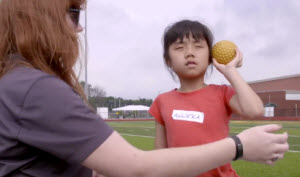“Just because I’m blind doesn’t mean I don’t know how to throw and catch,” – Anneka (aged 7)

In last month’s editorial, “The End of Physical Education as We Know It” I suggested that health education and physical education teaching was about to undergo a revolution. SHAPE America’s intent to get all of America’s school-aged students physically active and healthy within 14 years – 50 Million Strong by 2029(50MS) – marks the end of business as usual. It’s also a beginning.
Starting this year, all of us need to accept that “doing our best” when teaching isn’t good enough. If we want to get respected in our public schools we need to get onboard with not just “doing” but rather “achieving.” Math teachers whose students don’t develop math competencies aren’t highly regarded. Similarly, if our students can’t demonstrate something worthwhile they’ve learned from us, why should health and physical educators deserve respect?
In the past, the trouble has been that we’ve never agreed upon what students should be learning in our classes. What should they know and be able to do after our classes that they couldn’t do before? Well now we know. 50MS has set the bar height for all of us: It’s to get all of our students physically active and healthy within 14 years. And as one of the current presidential candidates would say, it’s “a ‘uge change!” It truly is.
Of course, getting some of the students we teach to be physically active and healthy is easy because they’re already there. Their parents have already done the work for us. It’s like having kids who can already read well entering our kindergarten classes. They start out with an advantage over other students. What do we do? We don’t hold them back but rather challenge them to improve further. So equally, or perhaps even more importantly, we must ensure that none of our students are left behind.
I noted last month that too often we fail to recognize the immense barriers that far too many students entering our schools face. Children from families of poverty often don’t live in circumstances where it’s easy for them to play outside, join sport teams, learn to swim, and enjoy healthy and nutritious foods. It’s not their fault and we mustn’t let the cards fate has dealt them hinder their chances of succeeding in our classes.
The same is true with children who come to our classes with different physical, sensory or intellectual abilities. I implied that these children with disabilities were “unlucky” last month and Lauren Lieberman, whose “Camp Abilities” for the visually impaired was recently featured on HBO’s Real Sports, called me to task for using that word. She pointed out that what some of us might view as a “handicap” should not be allowed to become handicapping. If you watch the movie you’ll see that because a child might be blind, it doesn’t mean that he or she can’t do the things we typically teach in class. We simply need to accommodate our teaching to help all children regardless of their abilities succeed. Because in the end, these children will be adults and it is our job to get everyone, irrespective of age, ability, socioeconomic status, race or gender to be physically active.
In one of his wonderful TED Talks Sir Ken Robinson goes to great lengths to emphasize that ALL children are different. No two are the same. And if you think about it he’s right. Which means that there is really no excuse for us not to succeed with getting all of America’s kids physically active and healthy. Sure there will be differences in how active or how healthy the students in our schools can be. But what’s most important is that with our guidance, each child we teach is as active and healthy that he or she is capable of being. Every child should be provided the opportunity to reach his or her full potential.
To do this, we all need to embrace universally designing our lessons to include every child and challenge each one to reach their full potential. If all of our students aren’t physically active and healthy today, we can be certain that nothing much is going to change if we keep doing the same things. Getting started is simple. Ask yourself, “What’s my number?” You don’t need to worry about getting 50 million kids physically active and healthy. Be responsible for just those who you teach. If all of us do this, together we’ll achieve 50MS.
